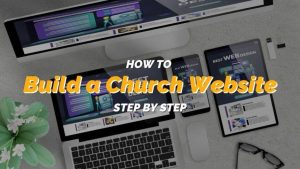How to Create a Website for Your Church
Introduction
A church website is a crucial tool for reaching out to your community, sharing information, and communicating with your congregation in today’s digital age. Creating a website may appear to be a daunting undertaking, particularly if you have no prior experience in web development. You can, however, develop a beautiful and useful website for your church with the correct strategy and resources. We will walk you through the procedure step by step in this article. How can I create a website for my church?

Step 1: Define Your Goals and Audience
Before getting into the technical components of building a website, it’s critical to identify your goals and target audience. Consider your website’s purpose: Is it simply informative, or would you wish to include services such as online donations, event registration, or sermon archives? Identifying your target audience will allow you to adjust the design and content to their specific requirements.
Step 2: Choose a Platform
To build a website for your church, you’ll need a dependable platform that makes web development easier. WordPress, Wix, Squarespace, and Joomla are just a few of the popular possibilities. These systems include user-friendly interfaces and a variety of customisable themes tailored exclusively for churches and religious organisations.
Step 3: Select a Domain and Hosting
Next, select a domain name that both symbolises your church and is easy for people to remember. Consider utilising the name of your church or a relevant term. Once you’ve decided on a domain name, you’ll need to choose a hosting company to store your website’s files and make it available on the internet. Many website builders provide hosting as part of their packages, making the process easier for you.
Step 4: Design and Layout
Your church website’s design and layout are critical in generating a favourable user experience. Most website builders offer pre-designed themes that you may customise to reflect the logo and style of your church. Consider variables like as colour palettes, font, and general look. Remember to keep your design clean, intuitive, and simple to use.
Step 5: Content Creation
About Us
The “About Us” page on your church website is one of the most significant aspects. Provide an overview of your church’s history, mission, and ideals in this section. Include biographical information for your pastors, staff, and leadership team. Including images and personal tales can assist to foster a sense of belonging and familiarity.
Services and Events
On a separate page, highlight your church’s regular services and unique events. Include service times, sermon themes, and any other pertinent information. Consider adding a calendar tool to your website that allows visitors to RSVP or register for events straight from your website.
Ministries and Programs
Create separate pages to highlight each of your church’s ministries or programmes if it has them. Individuals interested in participating should be given thorough descriptions, schedules, and contact information. Incorporating testimonials from current participants might aid in demonstrating the effectiveness of your church’s programmes.
Sermon Archives and Resources
Make sermons and other resources available to your congregation and the larger community. Consider adding a place where visitors can listen to or download previous sermons. To augment the learning experience, you can also include study tips, blog entries, or recommended reading lists. https://diversewebsitedesign.com.au/church-website-design/
Contact Information and Social Media Integration
Ensure that your contact information, such as your church’s address, phone number, and email address, is prominently displayed on your website. Consider incorporating a contact form. Including a contact form on your website allows visitors to easily contact your church with questions or prayer requests. Include social media buttons and links to your church’s social media profiles. This makes it simple for people to connect with your church and remain up to speed on the latest news and events.
Step 6: Optimization and Responsiveness
A effective church website should be search engine optimised so that it may be found by anyone looking for religious organisations in your area. Investigate relevant keywords and incorporate them naturally into the text of your website. Furthermore, ensure that your website is responsive, which means that it adapts smoothly to multiple screen sizes and devices, such as smartphones and tablets. A mobile-friendly website is required to reach a larger audience.
Step 7: Test and Launch
Test the functioning and performance of your website extensively before deploying it. Examine broken links, forms, and interactive elements, and evaluate the overall user experience. Make certain that all content is correct and up to date. When you’re certain that everything is in order, you can publish your website and share it with your congregation and community.
Step 8: Ongoing Maintenance and Updates
Creating a website for your church is a long-term project. To keep the content fresh and relevant, it requires ongoing maintenance and changes. Assign a team or individual to handle website maintenance, ensuring that information is updated on a regular basis, events are added or withdrawn, and technological concerns are resolved as soon as possible. Review your website’s performance on a regular basis with analytics tools to obtain insights and make informed decisions for improvement.
Conclusion
Creating a website for your church is an exciting project that may greatly improve your outreach efforts and enrich your community. You’ll be well on your way to constructing an impactful and functional website for your church if you follow these steps, which include defining your goals, selecting the correct platform, and providing compelling content. Utilise the potential of the digital age by using your website to connect, inform, and inspire your congregation and the larger community. https://www.dynamicwebdesign.com.au/our-services/australia-design-company/






